Comprehensive Nursing Care Plan: HLTENN004 Assignment, Semester 1
VerifiedAdded on 2021/05/31
|11
|2301
|140
Homework Assignment
AI Summary
This document presents a detailed nursing care plan assignment, addressing various aspects of patient care within the HLTENN004 module. It covers professional standards of practice for enrolled nurses, including legal and ethical considerations, patient rights, and confidentiality. The role of the enrolled nurse in relation to nursing care plans is outlined, emphasizing contributions to assessments, care provision, and patient education. The assignment thoroughly explains the nursing process, its components (assessment, diagnosis, planning, implementation, and evaluation), and its advantages. It also includes practical applications such as patient and family education, procedures and policies in nursing homes, and emergency protocols. The document addresses specific clinical scenarios, including oral pain, nutritional needs, and management of conditions like immobility and pressure ulcers. It highlights the use of equipment, medication administration, and documentation. Furthermore, it explores the benefits of clinical pathways and the requirements for formal teaching. Finally, it provides insights into evaluating care plans and managing activities of daily living, along with specific case studies involving diabetic patients and those with dementia. The assignment concludes with a review of blood glucose level management and self-testing procedures.
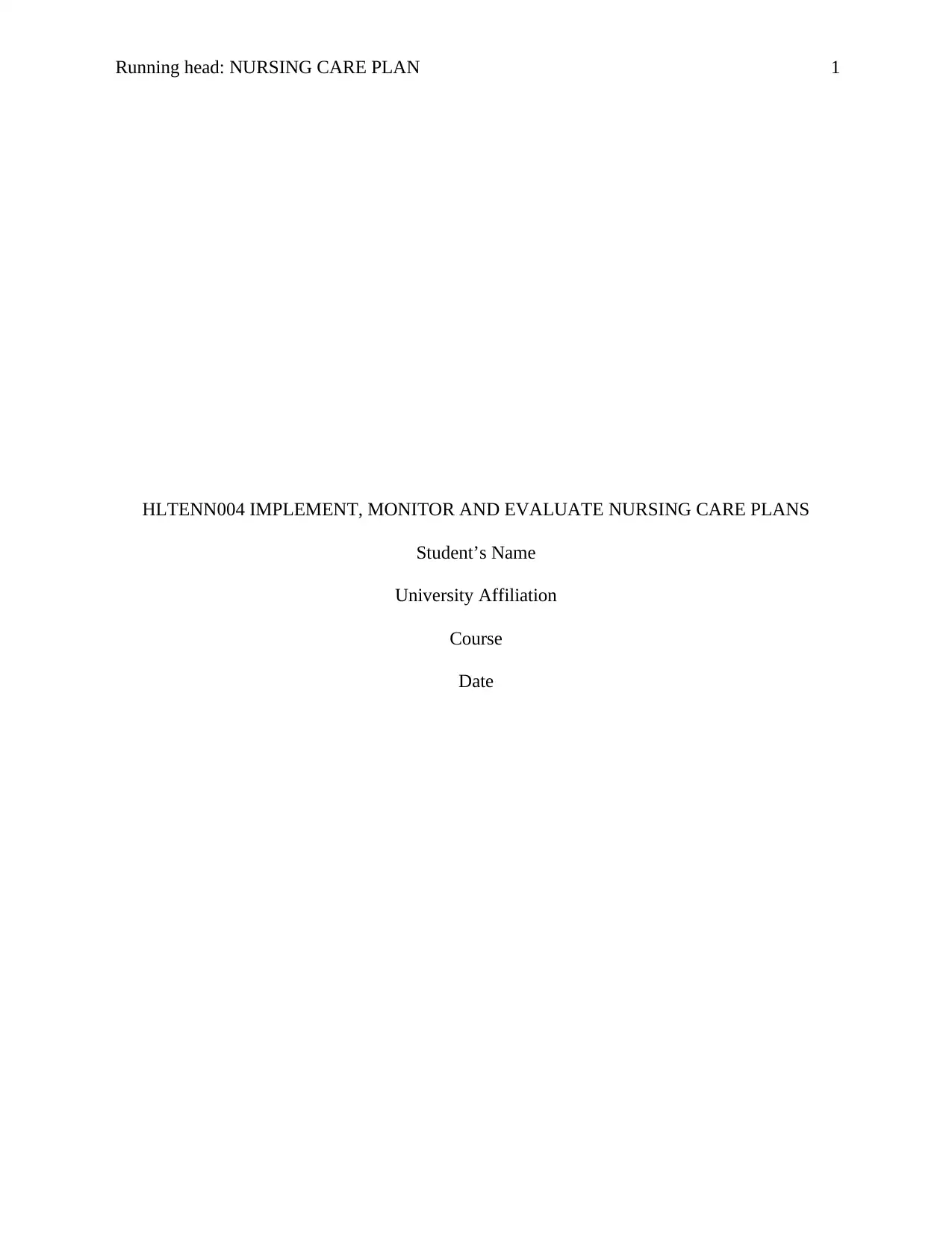
Running head: NURSING CARE PLAN 1
HLTENN004 IMPLEMENT, MONITOR AND EVALUATE NURSING CARE PLANS
Student’s Name
University Affiliation
Course
Date
HLTENN004 IMPLEMENT, MONITOR AND EVALUATE NURSING CARE PLANS
Student’s Name
University Affiliation
Course
Date
Paraphrase This Document
Need a fresh take? Get an instant paraphrase of this document with our AI Paraphraser
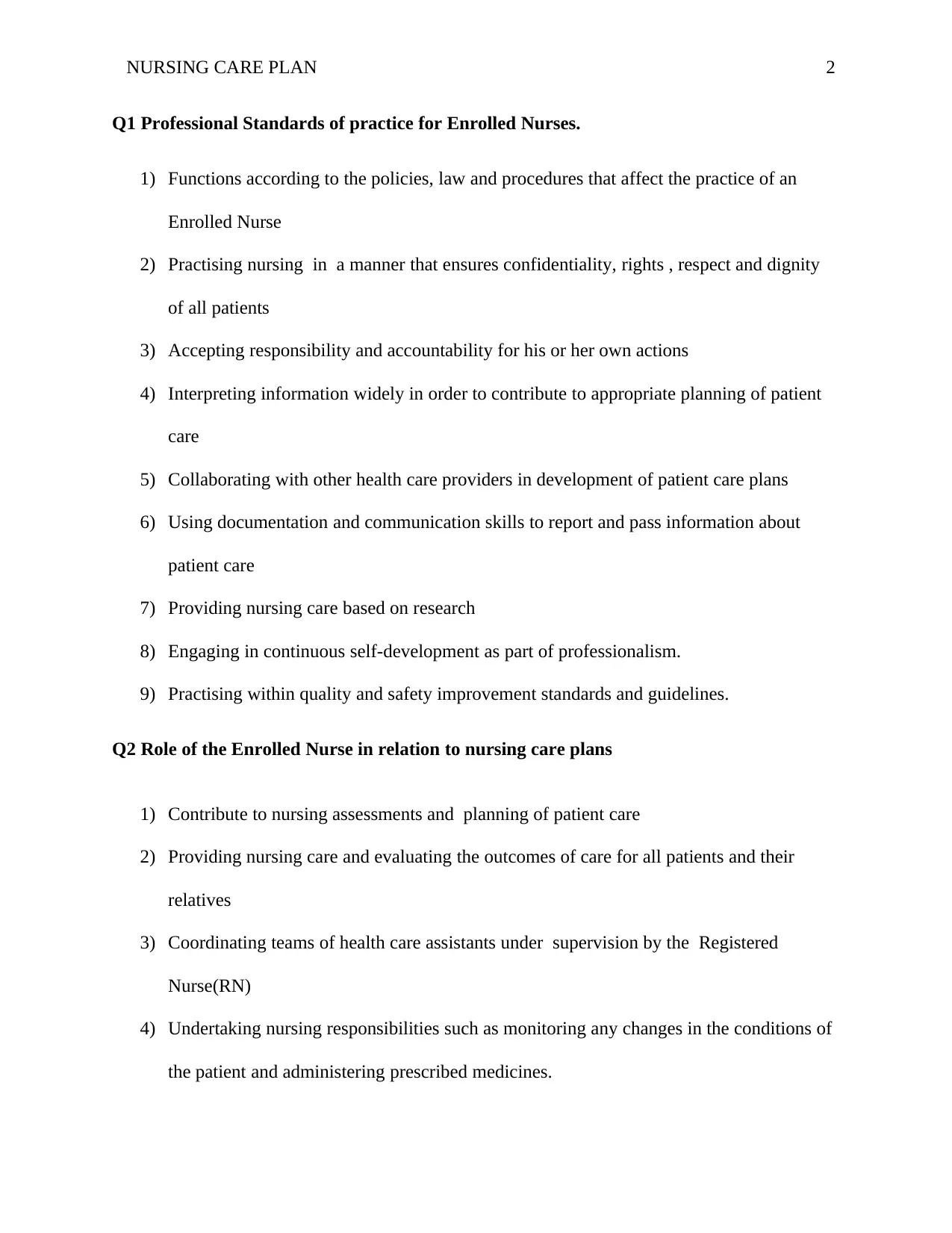
NURSING CARE PLAN 2
Q1 Professional Standards of practice for Enrolled Nurses.
1) Functions according to the policies, law and procedures that affect the practice of an
Enrolled Nurse
2) Practising nursing in a manner that ensures confidentiality, rights , respect and dignity
of all patients
3) Accepting responsibility and accountability for his or her own actions
4) Interpreting information widely in order to contribute to appropriate planning of patient
care
5) Collaborating with other health care providers in development of patient care plans
6) Using documentation and communication skills to report and pass information about
patient care
7) Providing nursing care based on research
8) Engaging in continuous self-development as part of professionalism.
9) Practising within quality and safety improvement standards and guidelines.
Q2 Role of the Enrolled Nurse in relation to nursing care plans
1) Contribute to nursing assessments and planning of patient care
2) Providing nursing care and evaluating the outcomes of care for all patients and their
relatives
3) Coordinating teams of health care assistants under supervision by the Registered
Nurse(RN)
4) Undertaking nursing responsibilities such as monitoring any changes in the conditions of
the patient and administering prescribed medicines.
Q1 Professional Standards of practice for Enrolled Nurses.
1) Functions according to the policies, law and procedures that affect the practice of an
Enrolled Nurse
2) Practising nursing in a manner that ensures confidentiality, rights , respect and dignity
of all patients
3) Accepting responsibility and accountability for his or her own actions
4) Interpreting information widely in order to contribute to appropriate planning of patient
care
5) Collaborating with other health care providers in development of patient care plans
6) Using documentation and communication skills to report and pass information about
patient care
7) Providing nursing care based on research
8) Engaging in continuous self-development as part of professionalism.
9) Practising within quality and safety improvement standards and guidelines.
Q2 Role of the Enrolled Nurse in relation to nursing care plans
1) Contribute to nursing assessments and planning of patient care
2) Providing nursing care and evaluating the outcomes of care for all patients and their
relatives
3) Coordinating teams of health care assistants under supervision by the Registered
Nurse(RN)
4) Undertaking nursing responsibilities such as monitoring any changes in the conditions of
the patient and administering prescribed medicines.
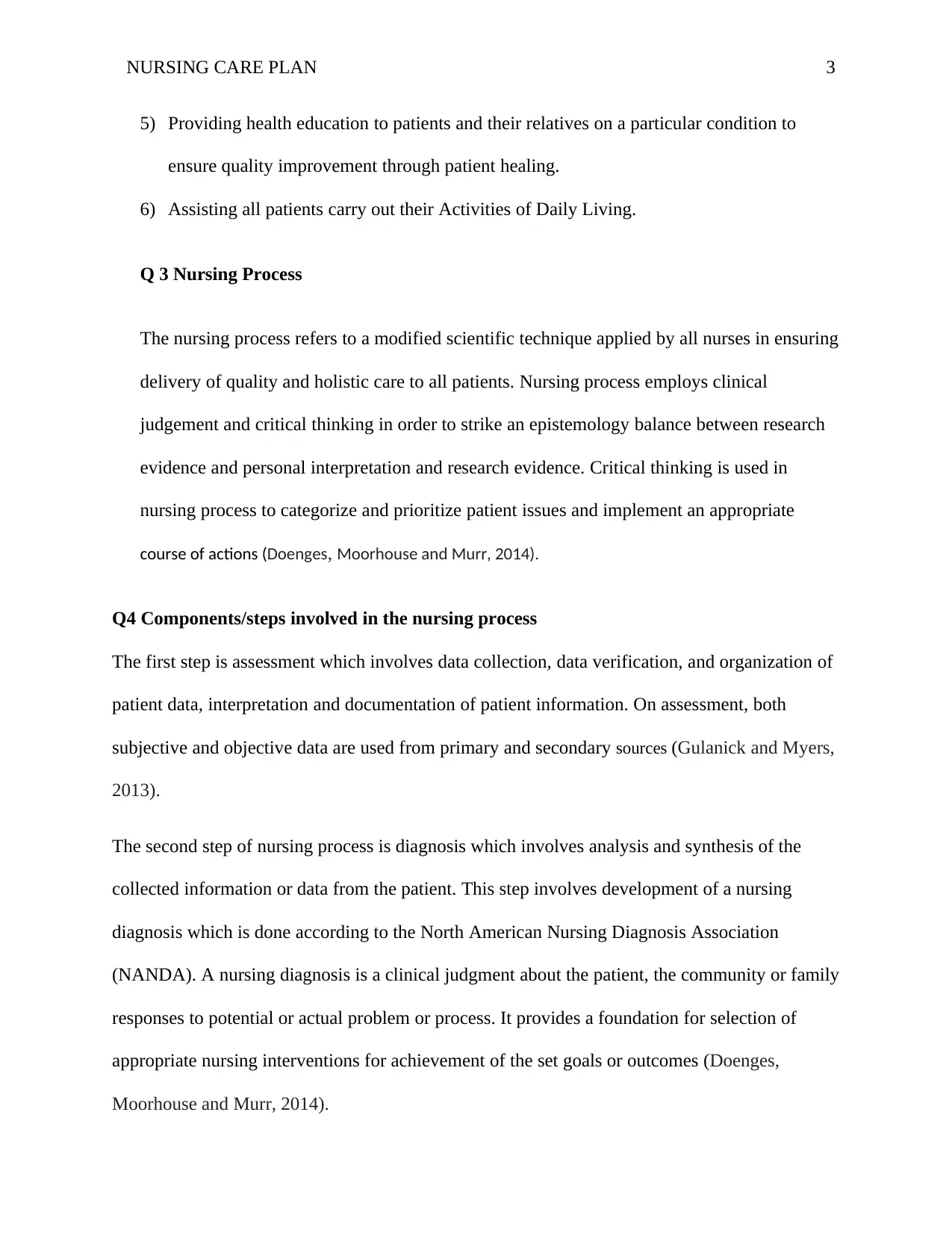
NURSING CARE PLAN 3
5) Providing health education to patients and their relatives on a particular condition to
ensure quality improvement through patient healing.
6) Assisting all patients carry out their Activities of Daily Living.
Q 3 Nursing Process
The nursing process refers to a modified scientific technique applied by all nurses in ensuring
delivery of quality and holistic care to all patients. Nursing process employs clinical
judgement and critical thinking in order to strike an epistemology balance between research
evidence and personal interpretation and research evidence. Critical thinking is used in
nursing process to categorize and prioritize patient issues and implement an appropriate
course of actions (Doenges, Moorhouse and Murr, 2014).
Q4 Components/steps involved in the nursing process
The first step is assessment which involves data collection, data verification, and organization of
patient data, interpretation and documentation of patient information. On assessment, both
subjective and objective data are used from primary and secondary sources (Gulanick and Myers,
2013).
The second step of nursing process is diagnosis which involves analysis and synthesis of the
collected information or data from the patient. This step involves development of a nursing
diagnosis which is done according to the North American Nursing Diagnosis Association
(NANDA). A nursing diagnosis is a clinical judgment about the patient, the community or family
responses to potential or actual problem or process. It provides a foundation for selection of
appropriate nursing interventions for achievement of the set goals or outcomes (Doenges,
Moorhouse and Murr, 2014).
5) Providing health education to patients and their relatives on a particular condition to
ensure quality improvement through patient healing.
6) Assisting all patients carry out their Activities of Daily Living.
Q 3 Nursing Process
The nursing process refers to a modified scientific technique applied by all nurses in ensuring
delivery of quality and holistic care to all patients. Nursing process employs clinical
judgement and critical thinking in order to strike an epistemology balance between research
evidence and personal interpretation and research evidence. Critical thinking is used in
nursing process to categorize and prioritize patient issues and implement an appropriate
course of actions (Doenges, Moorhouse and Murr, 2014).
Q4 Components/steps involved in the nursing process
The first step is assessment which involves data collection, data verification, and organization of
patient data, interpretation and documentation of patient information. On assessment, both
subjective and objective data are used from primary and secondary sources (Gulanick and Myers,
2013).
The second step of nursing process is diagnosis which involves analysis and synthesis of the
collected information or data from the patient. This step involves development of a nursing
diagnosis which is done according to the North American Nursing Diagnosis Association
(NANDA). A nursing diagnosis is a clinical judgment about the patient, the community or family
responses to potential or actual problem or process. It provides a foundation for selection of
appropriate nursing interventions for achievement of the set goals or outcomes (Doenges,
Moorhouse and Murr, 2014).
⊘ This is a preview!⊘
Do you want full access?
Subscribe today to unlock all pages.

Trusted by 1+ million students worldwide
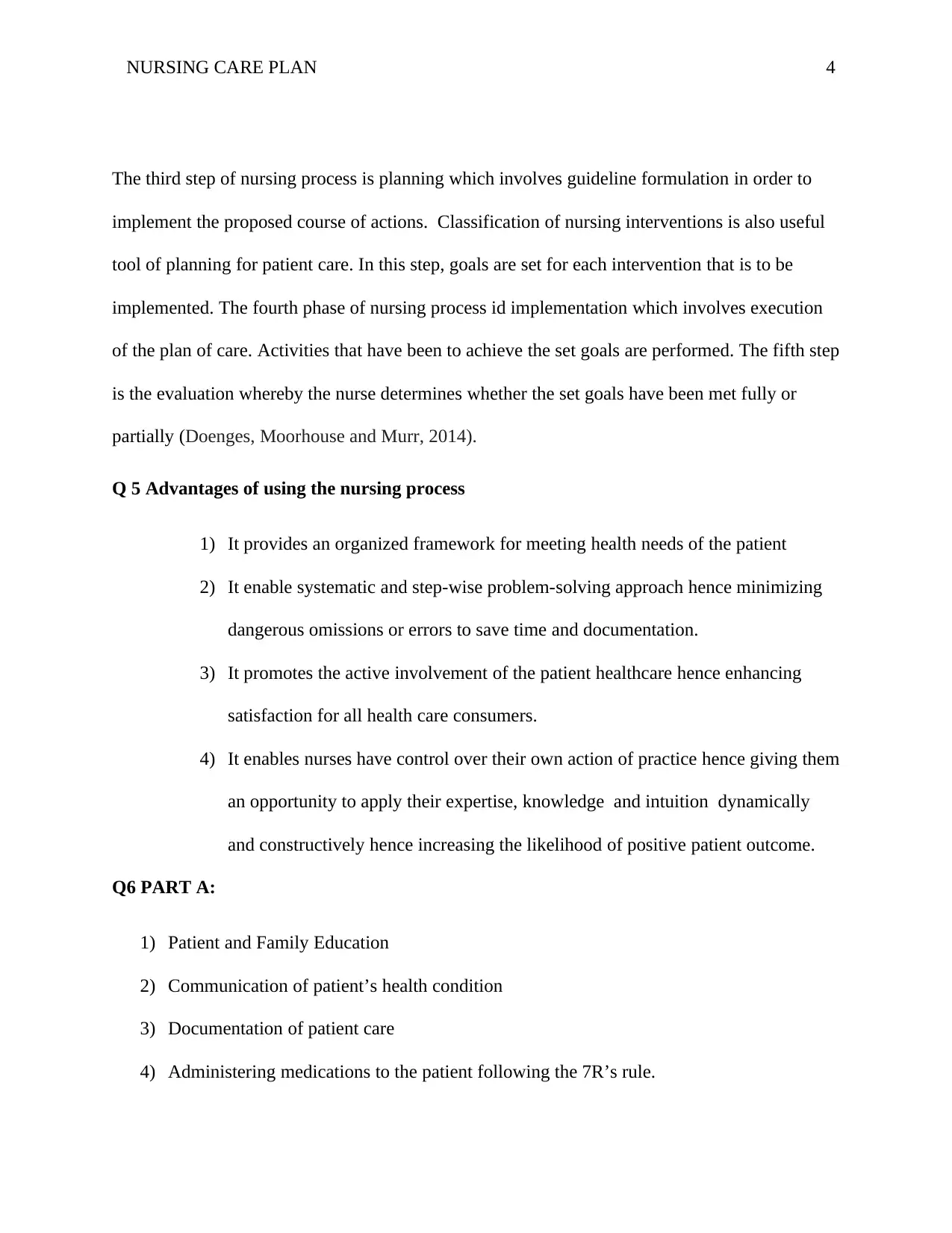
NURSING CARE PLAN 4
The third step of nursing process is planning which involves guideline formulation in order to
implement the proposed course of actions. Classification of nursing interventions is also useful
tool of planning for patient care. In this step, goals are set for each intervention that is to be
implemented. The fourth phase of nursing process id implementation which involves execution
of the plan of care. Activities that have been to achieve the set goals are performed. The fifth step
is the evaluation whereby the nurse determines whether the set goals have been met fully or
partially (Doenges, Moorhouse and Murr, 2014).
Q 5 Advantages of using the nursing process
1) It provides an organized framework for meeting health needs of the patient
2) It enable systematic and step-wise problem-solving approach hence minimizing
dangerous omissions or errors to save time and documentation.
3) It promotes the active involvement of the patient healthcare hence enhancing
satisfaction for all health care consumers.
4) It enables nurses have control over their own action of practice hence giving them
an opportunity to apply their expertise, knowledge and intuition dynamically
and constructively hence increasing the likelihood of positive patient outcome.
Q6 PART A:
1) Patient and Family Education
2) Communication of patient’s health condition
3) Documentation of patient care
4) Administering medications to the patient following the 7R’s rule.
The third step of nursing process is planning which involves guideline formulation in order to
implement the proposed course of actions. Classification of nursing interventions is also useful
tool of planning for patient care. In this step, goals are set for each intervention that is to be
implemented. The fourth phase of nursing process id implementation which involves execution
of the plan of care. Activities that have been to achieve the set goals are performed. The fifth step
is the evaluation whereby the nurse determines whether the set goals have been met fully or
partially (Doenges, Moorhouse and Murr, 2014).
Q 5 Advantages of using the nursing process
1) It provides an organized framework for meeting health needs of the patient
2) It enable systematic and step-wise problem-solving approach hence minimizing
dangerous omissions or errors to save time and documentation.
3) It promotes the active involvement of the patient healthcare hence enhancing
satisfaction for all health care consumers.
4) It enables nurses have control over their own action of practice hence giving them
an opportunity to apply their expertise, knowledge and intuition dynamically
and constructively hence increasing the likelihood of positive patient outcome.
Q6 PART A:
1) Patient and Family Education
2) Communication of patient’s health condition
3) Documentation of patient care
4) Administering medications to the patient following the 7R’s rule.
Paraphrase This Document
Need a fresh take? Get an instant paraphrase of this document with our AI Paraphraser
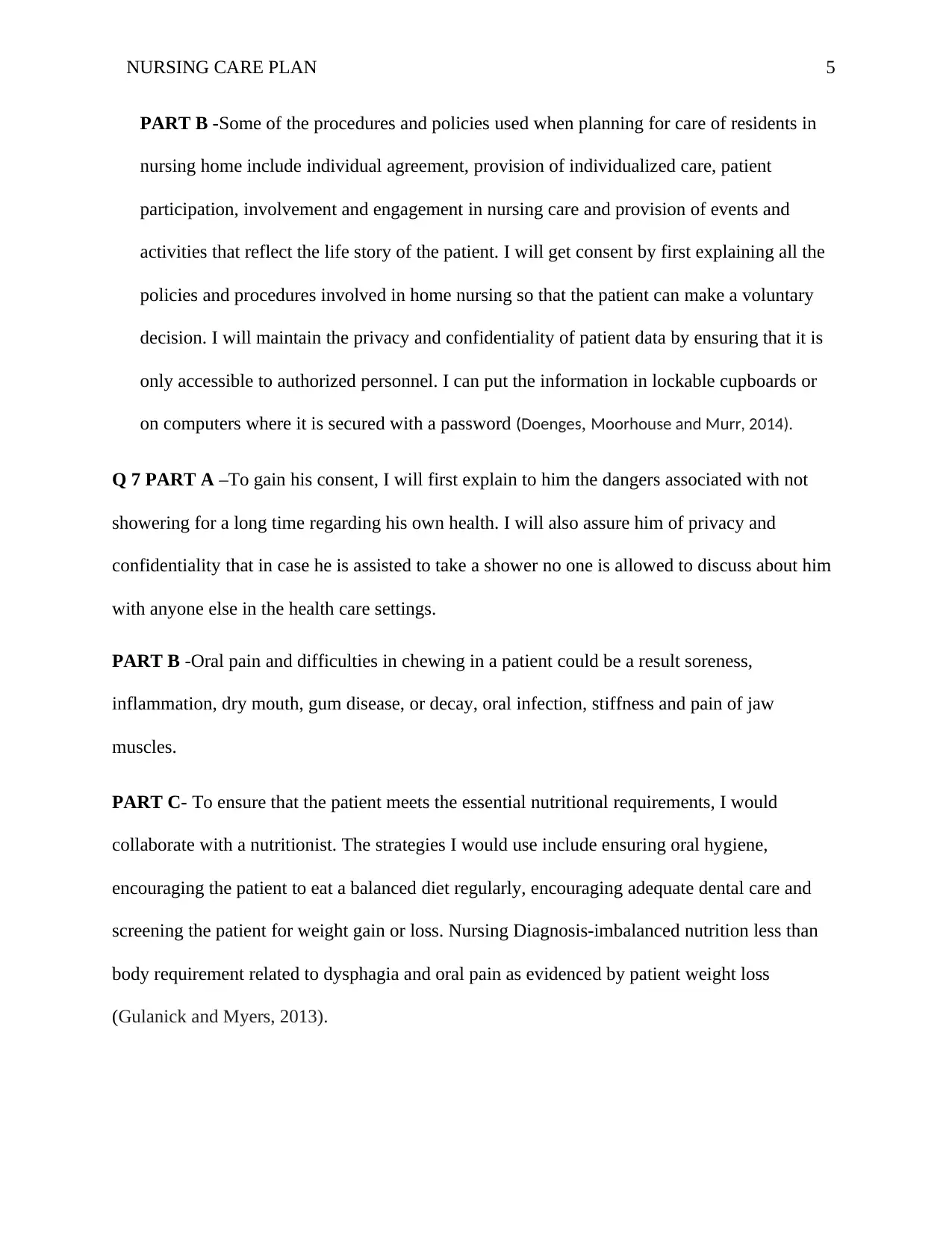
NURSING CARE PLAN 5
PART B -Some of the procedures and policies used when planning for care of residents in
nursing home include individual agreement, provision of individualized care, patient
participation, involvement and engagement in nursing care and provision of events and
activities that reflect the life story of the patient. I will get consent by first explaining all the
policies and procedures involved in home nursing so that the patient can make a voluntary
decision. I will maintain the privacy and confidentiality of patient data by ensuring that it is
only accessible to authorized personnel. I can put the information in lockable cupboards or
on computers where it is secured with a password (Doenges, Moorhouse and Murr, 2014).
Q 7 PART A –To gain his consent, I will first explain to him the dangers associated with not
showering for a long time regarding his own health. I will also assure him of privacy and
confidentiality that in case he is assisted to take a shower no one is allowed to discuss about him
with anyone else in the health care settings.
PART B -Oral pain and difficulties in chewing in a patient could be a result soreness,
inflammation, dry mouth, gum disease, or decay, oral infection, stiffness and pain of jaw
muscles.
PART C- To ensure that the patient meets the essential nutritional requirements, I would
collaborate with a nutritionist. The strategies I would use include ensuring oral hygiene,
encouraging the patient to eat a balanced diet regularly, encouraging adequate dental care and
screening the patient for weight gain or loss. Nursing Diagnosis-imbalanced nutrition less than
body requirement related to dysphagia and oral pain as evidenced by patient weight loss
(Gulanick and Myers, 2013).
PART B -Some of the procedures and policies used when planning for care of residents in
nursing home include individual agreement, provision of individualized care, patient
participation, involvement and engagement in nursing care and provision of events and
activities that reflect the life story of the patient. I will get consent by first explaining all the
policies and procedures involved in home nursing so that the patient can make a voluntary
decision. I will maintain the privacy and confidentiality of patient data by ensuring that it is
only accessible to authorized personnel. I can put the information in lockable cupboards or
on computers where it is secured with a password (Doenges, Moorhouse and Murr, 2014).
Q 7 PART A –To gain his consent, I will first explain to him the dangers associated with not
showering for a long time regarding his own health. I will also assure him of privacy and
confidentiality that in case he is assisted to take a shower no one is allowed to discuss about him
with anyone else in the health care settings.
PART B -Oral pain and difficulties in chewing in a patient could be a result soreness,
inflammation, dry mouth, gum disease, or decay, oral infection, stiffness and pain of jaw
muscles.
PART C- To ensure that the patient meets the essential nutritional requirements, I would
collaborate with a nutritionist. The strategies I would use include ensuring oral hygiene,
encouraging the patient to eat a balanced diet regularly, encouraging adequate dental care and
screening the patient for weight gain or loss. Nursing Diagnosis-imbalanced nutrition less than
body requirement related to dysphagia and oral pain as evidenced by patient weight loss
(Gulanick and Myers, 2013).
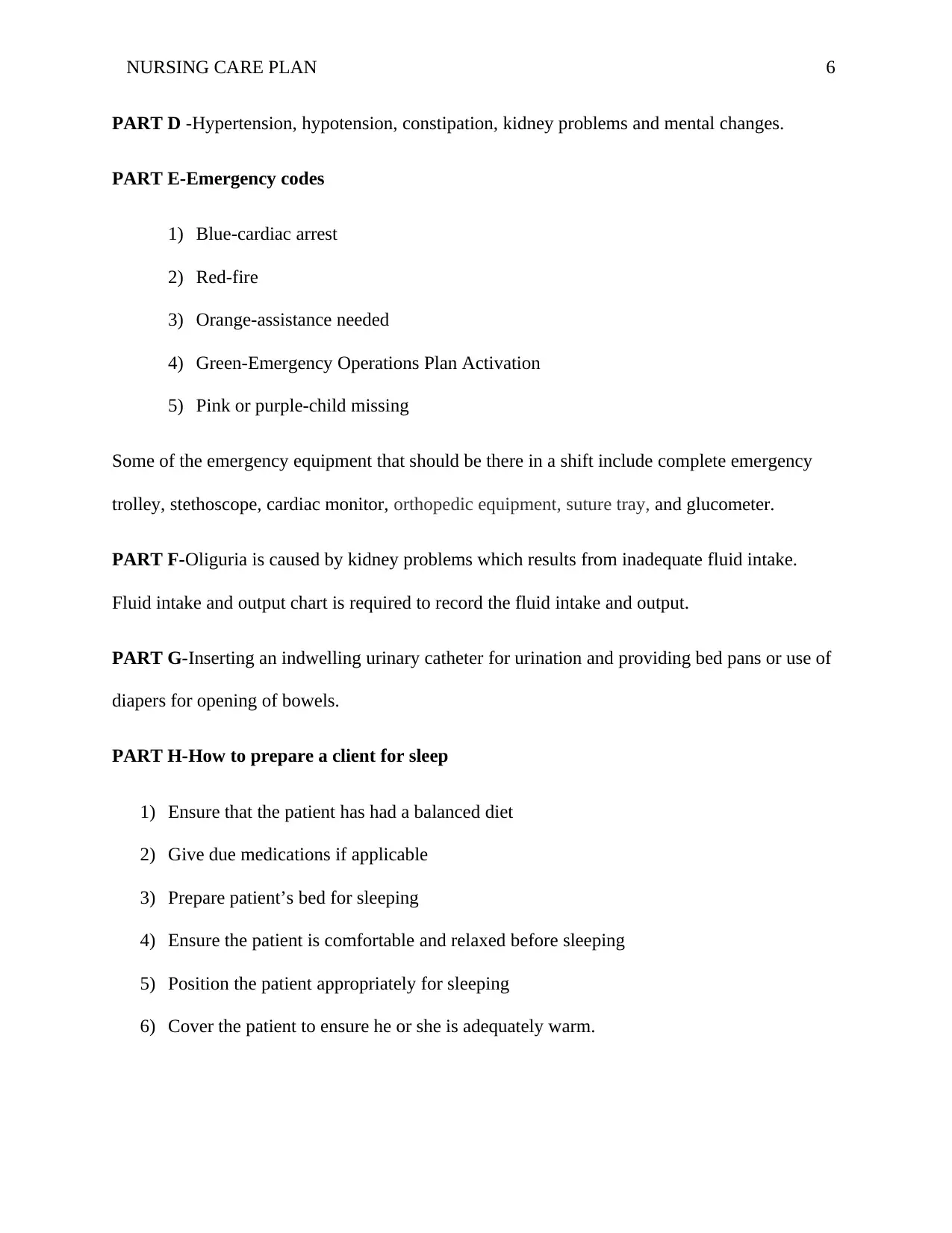
NURSING CARE PLAN 6
PART D -Hypertension, hypotension, constipation, kidney problems and mental changes.
PART E-Emergency codes
1) Blue-cardiac arrest
2) Red-fire
3) Orange-assistance needed
4) Green-Emergency Operations Plan Activation
5) Pink or purple-child missing
Some of the emergency equipment that should be there in a shift include complete emergency
trolley, stethoscope, cardiac monitor, orthopedic equipment, suture tray, and glucometer.
PART F-Oliguria is caused by kidney problems which results from inadequate fluid intake.
Fluid intake and output chart is required to record the fluid intake and output.
PART G-Inserting an indwelling urinary catheter for urination and providing bed pans or use of
diapers for opening of bowels.
PART H-How to prepare a client for sleep
1) Ensure that the patient has had a balanced diet
2) Give due medications if applicable
3) Prepare patient’s bed for sleeping
4) Ensure the patient is comfortable and relaxed before sleeping
5) Position the patient appropriately for sleeping
6) Cover the patient to ensure he or she is adequately warm.
PART D -Hypertension, hypotension, constipation, kidney problems and mental changes.
PART E-Emergency codes
1) Blue-cardiac arrest
2) Red-fire
3) Orange-assistance needed
4) Green-Emergency Operations Plan Activation
5) Pink or purple-child missing
Some of the emergency equipment that should be there in a shift include complete emergency
trolley, stethoscope, cardiac monitor, orthopedic equipment, suture tray, and glucometer.
PART F-Oliguria is caused by kidney problems which results from inadequate fluid intake.
Fluid intake and output chart is required to record the fluid intake and output.
PART G-Inserting an indwelling urinary catheter for urination and providing bed pans or use of
diapers for opening of bowels.
PART H-How to prepare a client for sleep
1) Ensure that the patient has had a balanced diet
2) Give due medications if applicable
3) Prepare patient’s bed for sleeping
4) Ensure the patient is comfortable and relaxed before sleeping
5) Position the patient appropriately for sleeping
6) Cover the patient to ensure he or she is adequately warm.
⊘ This is a preview!⊘
Do you want full access?
Subscribe today to unlock all pages.

Trusted by 1+ million students worldwide
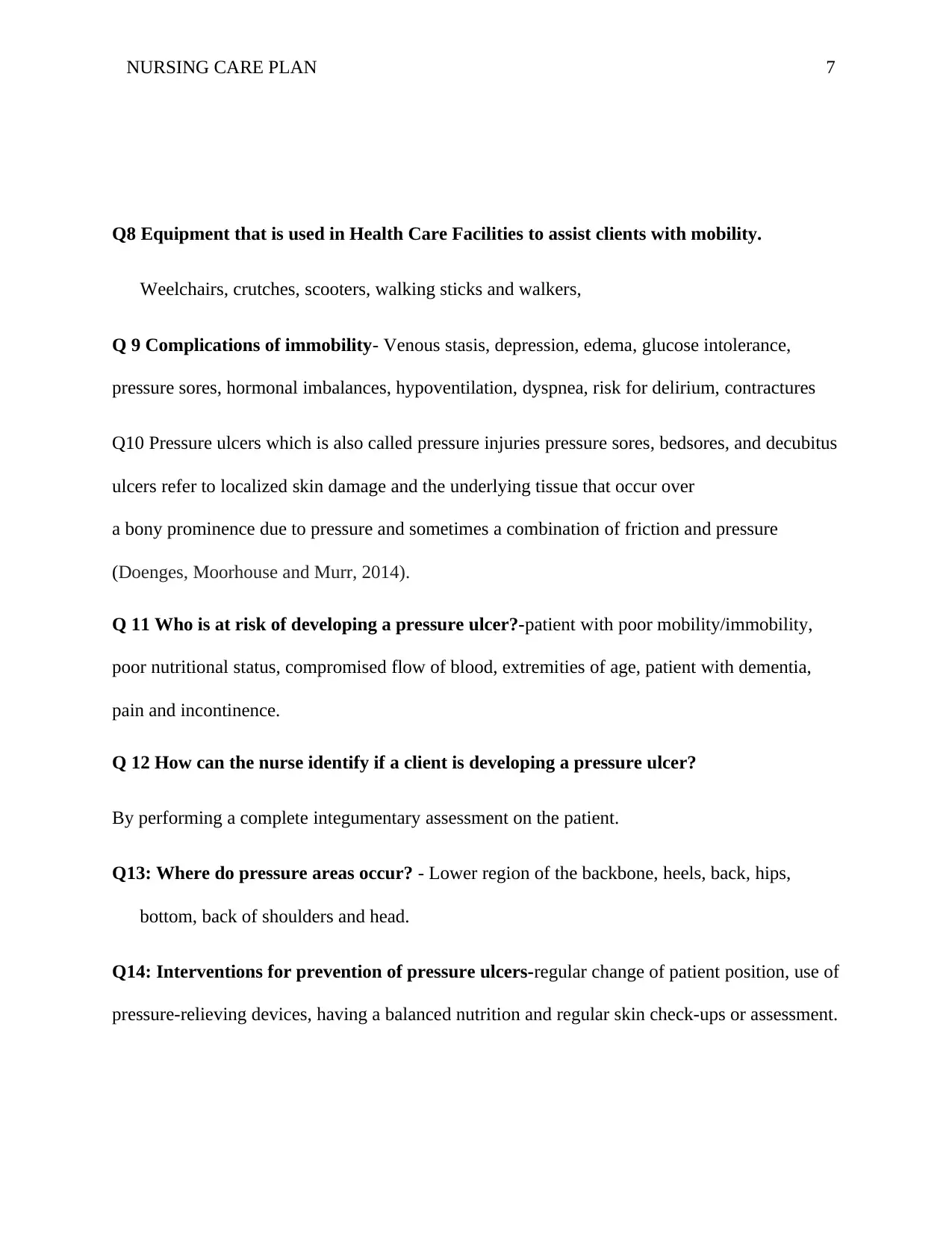
NURSING CARE PLAN 7
Q8 Equipment that is used in Health Care Facilities to assist clients with mobility.
Weelchairs, crutches, scooters, walking sticks and walkers,
Q 9 Complications of immobility- Venous stasis, depression, edema, glucose intolerance,
pressure sores, hormonal imbalances, hypoventilation, dyspnea, risk for delirium, contractures
Q10 Pressure ulcers which is also called pressure injuries pressure sores, bedsores, and decubitus
ulcers refer to localized skin damage and the underlying tissue that occur over
a bony prominence due to pressure and sometimes a combination of friction and pressure
(Doenges, Moorhouse and Murr, 2014).
Q 11 Who is at risk of developing a pressure ulcer?-patient with poor mobility/immobility,
poor nutritional status, compromised flow of blood, extremities of age, patient with dementia,
pain and incontinence.
Q 12 How can the nurse identify if a client is developing a pressure ulcer?
By performing a complete integumentary assessment on the patient.
Q13: Where do pressure areas occur? - Lower region of the backbone, heels, back, hips,
bottom, back of shoulders and head.
Q14: Interventions for prevention of pressure ulcers-regular change of patient position, use of
pressure-relieving devices, having a balanced nutrition and regular skin check-ups or assessment.
Q8 Equipment that is used in Health Care Facilities to assist clients with mobility.
Weelchairs, crutches, scooters, walking sticks and walkers,
Q 9 Complications of immobility- Venous stasis, depression, edema, glucose intolerance,
pressure sores, hormonal imbalances, hypoventilation, dyspnea, risk for delirium, contractures
Q10 Pressure ulcers which is also called pressure injuries pressure sores, bedsores, and decubitus
ulcers refer to localized skin damage and the underlying tissue that occur over
a bony prominence due to pressure and sometimes a combination of friction and pressure
(Doenges, Moorhouse and Murr, 2014).
Q 11 Who is at risk of developing a pressure ulcer?-patient with poor mobility/immobility,
poor nutritional status, compromised flow of blood, extremities of age, patient with dementia,
pain and incontinence.
Q 12 How can the nurse identify if a client is developing a pressure ulcer?
By performing a complete integumentary assessment on the patient.
Q13: Where do pressure areas occur? - Lower region of the backbone, heels, back, hips,
bottom, back of shoulders and head.
Q14: Interventions for prevention of pressure ulcers-regular change of patient position, use of
pressure-relieving devices, having a balanced nutrition and regular skin check-ups or assessment.
Paraphrase This Document
Need a fresh take? Get an instant paraphrase of this document with our AI Paraphraser
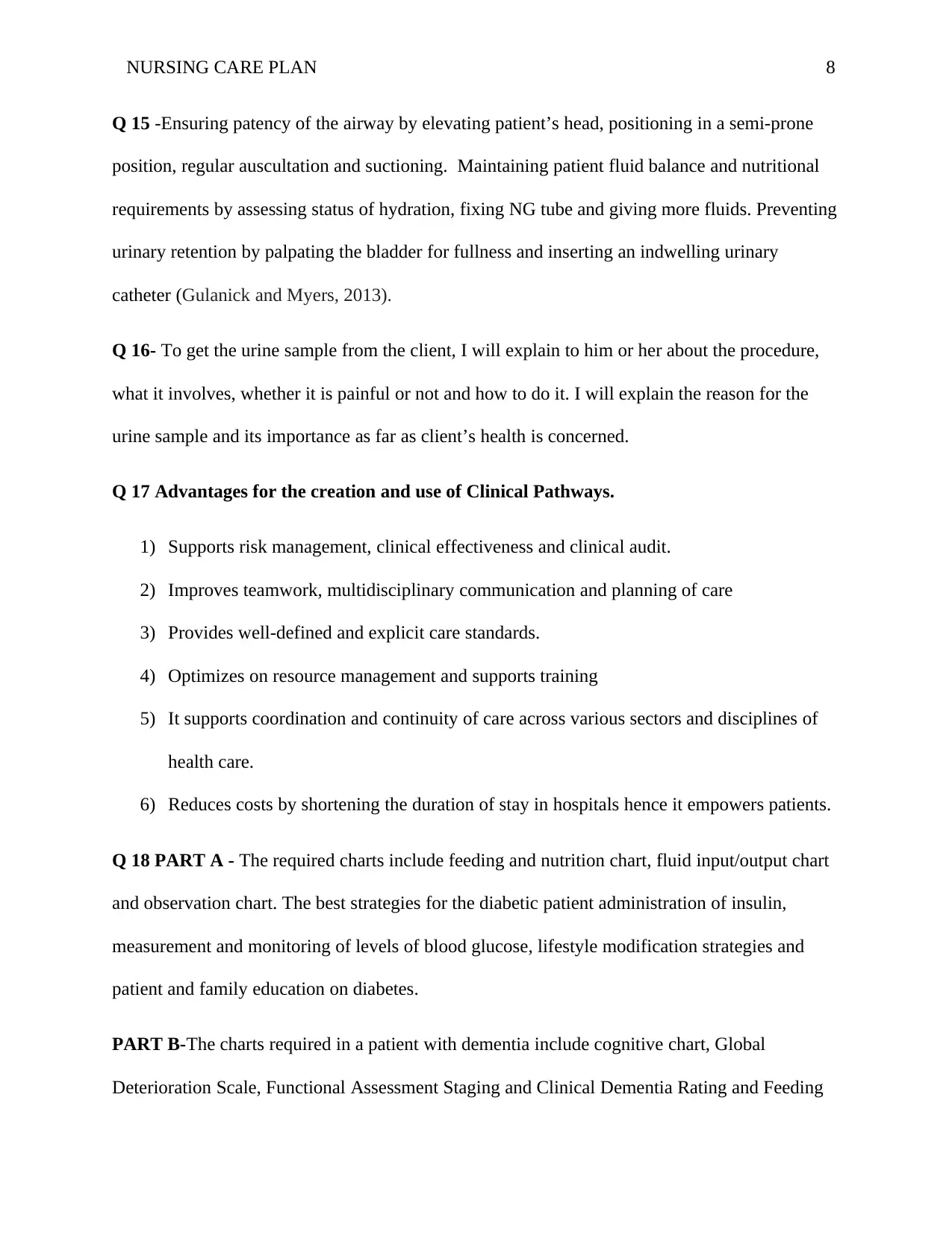
NURSING CARE PLAN 8
Q 15 -Ensuring patency of the airway by elevating patient’s head, positioning in a semi-prone
position, regular auscultation and suctioning. Maintaining patient fluid balance and nutritional
requirements by assessing status of hydration, fixing NG tube and giving more fluids. Preventing
urinary retention by palpating the bladder for fullness and inserting an indwelling urinary
catheter (Gulanick and Myers, 2013).
Q 16- To get the urine sample from the client, I will explain to him or her about the procedure,
what it involves, whether it is painful or not and how to do it. I will explain the reason for the
urine sample and its importance as far as client’s health is concerned.
Q 17 Advantages for the creation and use of Clinical Pathways.
1) Supports risk management, clinical effectiveness and clinical audit.
2) Improves teamwork, multidisciplinary communication and planning of care
3) Provides well-defined and explicit care standards.
4) Optimizes on resource management and supports training
5) It supports coordination and continuity of care across various sectors and disciplines of
health care.
6) Reduces costs by shortening the duration of stay in hospitals hence it empowers patients.
Q 18 PART A - The required charts include feeding and nutrition chart, fluid input/output chart
and observation chart. The best strategies for the diabetic patient administration of insulin,
measurement and monitoring of levels of blood glucose, lifestyle modification strategies and
patient and family education on diabetes.
PART B-The charts required in a patient with dementia include cognitive chart, Global
Deterioration Scale, Functional Assessment Staging and Clinical Dementia Rating and Feeding
Q 15 -Ensuring patency of the airway by elevating patient’s head, positioning in a semi-prone
position, regular auscultation and suctioning. Maintaining patient fluid balance and nutritional
requirements by assessing status of hydration, fixing NG tube and giving more fluids. Preventing
urinary retention by palpating the bladder for fullness and inserting an indwelling urinary
catheter (Gulanick and Myers, 2013).
Q 16- To get the urine sample from the client, I will explain to him or her about the procedure,
what it involves, whether it is painful or not and how to do it. I will explain the reason for the
urine sample and its importance as far as client’s health is concerned.
Q 17 Advantages for the creation and use of Clinical Pathways.
1) Supports risk management, clinical effectiveness and clinical audit.
2) Improves teamwork, multidisciplinary communication and planning of care
3) Provides well-defined and explicit care standards.
4) Optimizes on resource management and supports training
5) It supports coordination and continuity of care across various sectors and disciplines of
health care.
6) Reduces costs by shortening the duration of stay in hospitals hence it empowers patients.
Q 18 PART A - The required charts include feeding and nutrition chart, fluid input/output chart
and observation chart. The best strategies for the diabetic patient administration of insulin,
measurement and monitoring of levels of blood glucose, lifestyle modification strategies and
patient and family education on diabetes.
PART B-The charts required in a patient with dementia include cognitive chart, Global
Deterioration Scale, Functional Assessment Staging and Clinical Dementia Rating and Feeding
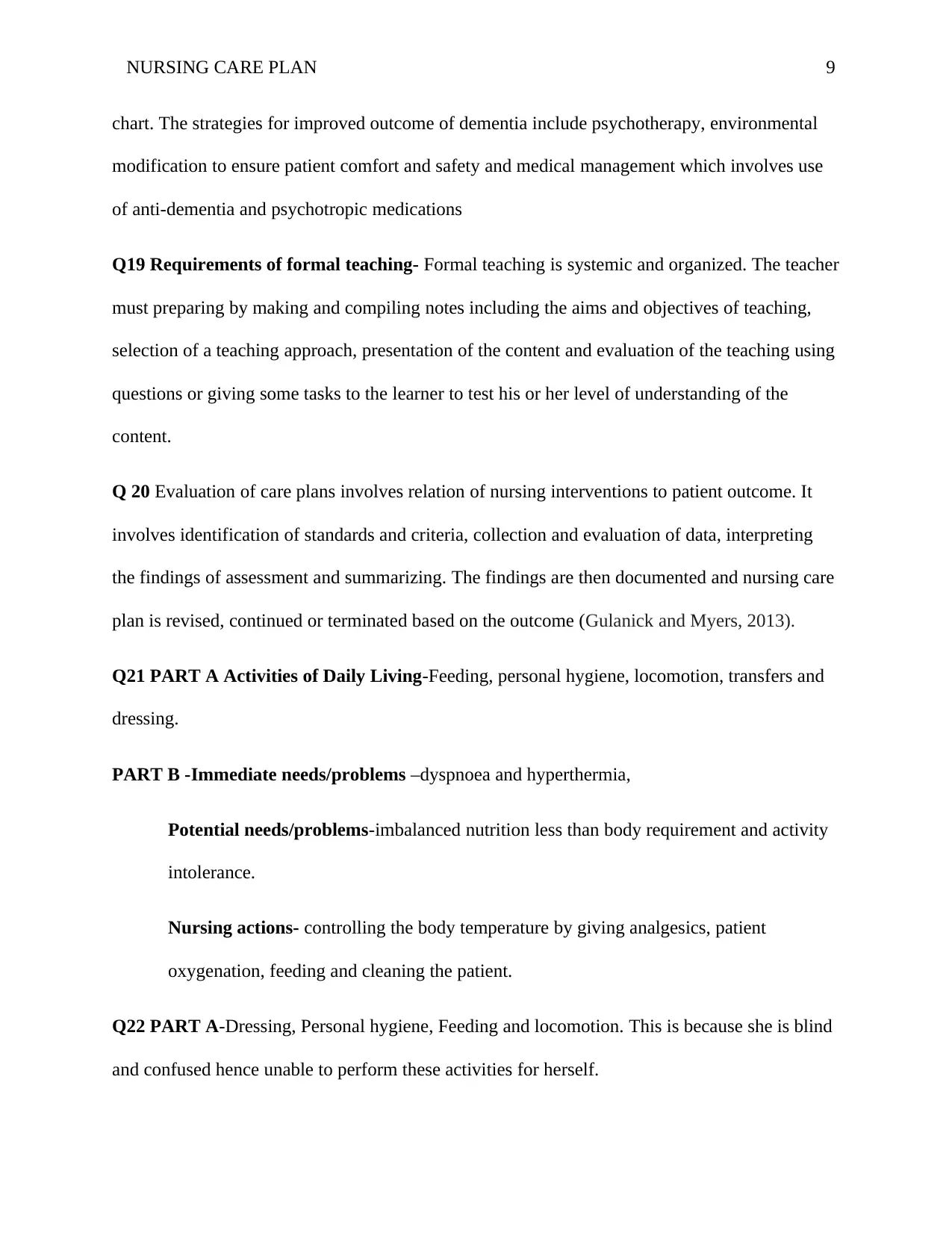
NURSING CARE PLAN 9
chart. The strategies for improved outcome of dementia include psychotherapy, environmental
modification to ensure patient comfort and safety and medical management which involves use
of anti-dementia and psychotropic medications
Q19 Requirements of formal teaching- Formal teaching is systemic and organized. The teacher
must preparing by making and compiling notes including the aims and objectives of teaching,
selection of a teaching approach, presentation of the content and evaluation of the teaching using
questions or giving some tasks to the learner to test his or her level of understanding of the
content.
Q 20 Evaluation of care plans involves relation of nursing interventions to patient outcome. It
involves identification of standards and criteria, collection and evaluation of data, interpreting
the findings of assessment and summarizing. The findings are then documented and nursing care
plan is revised, continued or terminated based on the outcome (Gulanick and Myers, 2013).
Q21 PART A Activities of Daily Living-Feeding, personal hygiene, locomotion, transfers and
dressing.
PART B -Immediate needs/problems –dyspnoea and hyperthermia,
Potential needs/problems-imbalanced nutrition less than body requirement and activity
intolerance.
Nursing actions- controlling the body temperature by giving analgesics, patient
oxygenation, feeding and cleaning the patient.
Q22 PART A-Dressing, Personal hygiene, Feeding and locomotion. This is because she is blind
and confused hence unable to perform these activities for herself.
chart. The strategies for improved outcome of dementia include psychotherapy, environmental
modification to ensure patient comfort and safety and medical management which involves use
of anti-dementia and psychotropic medications
Q19 Requirements of formal teaching- Formal teaching is systemic and organized. The teacher
must preparing by making and compiling notes including the aims and objectives of teaching,
selection of a teaching approach, presentation of the content and evaluation of the teaching using
questions or giving some tasks to the learner to test his or her level of understanding of the
content.
Q 20 Evaluation of care plans involves relation of nursing interventions to patient outcome. It
involves identification of standards and criteria, collection and evaluation of data, interpreting
the findings of assessment and summarizing. The findings are then documented and nursing care
plan is revised, continued or terminated based on the outcome (Gulanick and Myers, 2013).
Q21 PART A Activities of Daily Living-Feeding, personal hygiene, locomotion, transfers and
dressing.
PART B -Immediate needs/problems –dyspnoea and hyperthermia,
Potential needs/problems-imbalanced nutrition less than body requirement and activity
intolerance.
Nursing actions- controlling the body temperature by giving analgesics, patient
oxygenation, feeding and cleaning the patient.
Q22 PART A-Dressing, Personal hygiene, Feeding and locomotion. This is because she is blind
and confused hence unable to perform these activities for herself.
⊘ This is a preview!⊘
Do you want full access?
Subscribe today to unlock all pages.

Trusted by 1+ million students worldwide
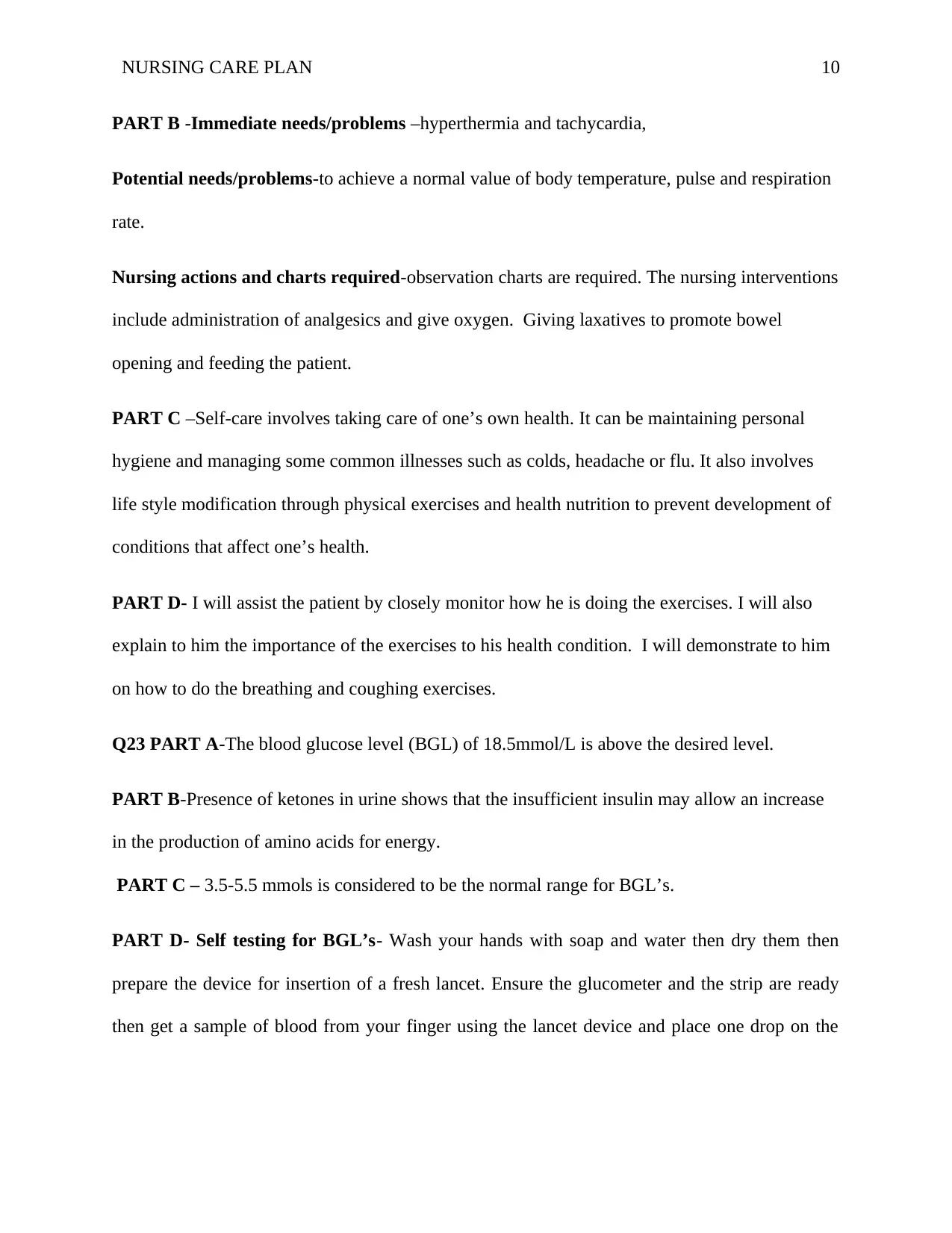
NURSING CARE PLAN 10
PART B -Immediate needs/problems –hyperthermia and tachycardia,
Potential needs/problems-to achieve a normal value of body temperature, pulse and respiration
rate.
Nursing actions and charts required-observation charts are required. The nursing interventions
include administration of analgesics and give oxygen. Giving laxatives to promote bowel
opening and feeding the patient.
PART C –Self-care involves taking care of one’s own health. It can be maintaining personal
hygiene and managing some common illnesses such as colds, headache or flu. It also involves
life style modification through physical exercises and health nutrition to prevent development of
conditions that affect one’s health.
PART D- I will assist the patient by closely monitor how he is doing the exercises. I will also
explain to him the importance of the exercises to his health condition. I will demonstrate to him
on how to do the breathing and coughing exercises.
Q23 PART A-The blood glucose level (BGL) of 18.5mmol/L is above the desired level.
PART B-Presence of ketones in urine shows that the insufficient insulin may allow an increase
in the production of amino acids for energy.
PART C – 3.5-5.5 mmols is considered to be the normal range for BGL’s.
PART D- Self testing for BGL’s- Wash your hands with soap and water then dry them then
prepare the device for insertion of a fresh lancet. Ensure the glucometer and the strip are ready
then get a sample of blood from your finger using the lancet device and place one drop on the
PART B -Immediate needs/problems –hyperthermia and tachycardia,
Potential needs/problems-to achieve a normal value of body temperature, pulse and respiration
rate.
Nursing actions and charts required-observation charts are required. The nursing interventions
include administration of analgesics and give oxygen. Giving laxatives to promote bowel
opening and feeding the patient.
PART C –Self-care involves taking care of one’s own health. It can be maintaining personal
hygiene and managing some common illnesses such as colds, headache or flu. It also involves
life style modification through physical exercises and health nutrition to prevent development of
conditions that affect one’s health.
PART D- I will assist the patient by closely monitor how he is doing the exercises. I will also
explain to him the importance of the exercises to his health condition. I will demonstrate to him
on how to do the breathing and coughing exercises.
Q23 PART A-The blood glucose level (BGL) of 18.5mmol/L is above the desired level.
PART B-Presence of ketones in urine shows that the insufficient insulin may allow an increase
in the production of amino acids for energy.
PART C – 3.5-5.5 mmols is considered to be the normal range for BGL’s.
PART D- Self testing for BGL’s- Wash your hands with soap and water then dry them then
prepare the device for insertion of a fresh lancet. Ensure the glucometer and the strip are ready
then get a sample of blood from your finger using the lancet device and place one drop on the
Paraphrase This Document
Need a fresh take? Get an instant paraphrase of this document with our AI Paraphraser
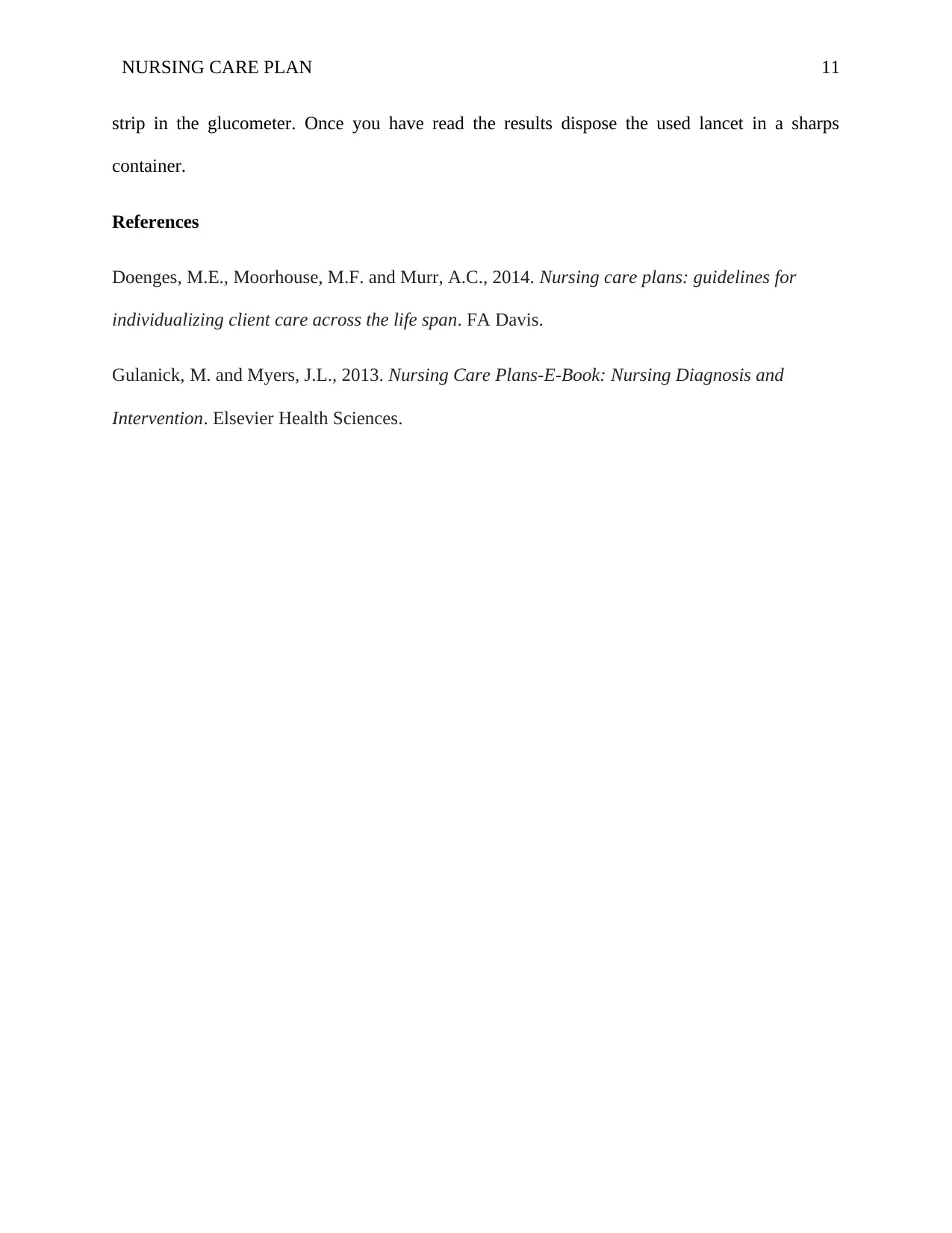
NURSING CARE PLAN 11
strip in the glucometer. Once you have read the results dispose the used lancet in a sharps
container.
References
Doenges, M.E., Moorhouse, M.F. and Murr, A.C., 2014. Nursing care plans: guidelines for
individualizing client care across the life span. FA Davis.
Gulanick, M. and Myers, J.L., 2013. Nursing Care Plans-E-Book: Nursing Diagnosis and
Intervention. Elsevier Health Sciences.
strip in the glucometer. Once you have read the results dispose the used lancet in a sharps
container.
References
Doenges, M.E., Moorhouse, M.F. and Murr, A.C., 2014. Nursing care plans: guidelines for
individualizing client care across the life span. FA Davis.
Gulanick, M. and Myers, J.L., 2013. Nursing Care Plans-E-Book: Nursing Diagnosis and
Intervention. Elsevier Health Sciences.
1 out of 11
Related Documents
Your All-in-One AI-Powered Toolkit for Academic Success.
+13062052269
info@desklib.com
Available 24*7 on WhatsApp / Email
![[object Object]](/_next/static/media/star-bottom.7253800d.svg)
Unlock your academic potential
Copyright © 2020–2025 A2Z Services. All Rights Reserved. Developed and managed by ZUCOL.





